Don't wanna be here? Send us removal request.
Text
CHARACTER TYPES
if you want to study aspects of film, i think its pretty apparent you need to have at least a basic understanding of how to write a believable, and engaging character.
I personally prefer characters who are flawed, and have to overcome personal obstacles on their journey, to achieve greatness and success in their story - I’m not too big on tropes about how someone is the ‘hero of destiny: an all mighty chosen one - gifted with divine power’ and all that rubbish.
I’ve seen this trope played with in interesting ways, sure - but generally: the scummier, and more flawed a character is, the more i like them.
however, with so many characters across so many different forms of storytelling media theres bound to be some crossover, right? i mean - there’s no way that every character is unique, we as humans share plenty of personality traits: its not unlikely that theres a set of ‘default settings’ that pretty much everything can be broken down to
yep - there is. otherwise i wouldn't be writing this post.
it’s my duty in this post to introduce you to some generic character types, you might find across your media consumption~ and as such, you’ll now be able to analyse and break down pretty much any character driven piece, with these principles:
PROTAGONIST:
A protagonist is the main character of a story. the leading character, who makes key decisions that affect the plot, primarily influencing the story and propelling it forward

every good story needs someone to follow, and a protagonist is exactly that.
they’re usually the hero of the story, however especially recently this trope has been twisted and experimented with to death - by showcasing the story of a villain triumphing over good.
ANTAGONIST:
a person who actively opposes or is hostile to someone or something; an adversary.

there’s an infinite number of iconic matchups: Kirby vs. MetaKnight, Samus vs. Ridley, Peter Griffin vs Homer Simpson - the point is, Mario and Bowser are clear representatives of the theme i thought would be beneficial to use.
Mario wants to rescue Princess Peach, from the clutches of her kidnapper - and Bowser is the one who keeps kidnapping her. their motives completely oppose one another.
you control Mario - the story is told from his perspective, making him the protagonist of the story. he’s the hero, he’s the one with the goal - he has to rescue his love interest from King Koopa.
Bowser is trying to stop Mario, and therefore you from reaching your goal: therefore in the formulaic story, he is the antagonist. the character in a story who is presented as the chief foe. The one stopping the protagonist.
DEUTERAGONIST:
The deuteragonist is the secondary character, right behind the protagonist in importance.

The deuteragonist may be on the protagonist's side: for example, a love interest or sidekick. Or the deuteragonist can be a villain, like the protagonist's main rival.
point being: they’re the secondary main character, the second most important character, after the protagonist and before the tritagonist. The deuteragonist may switch between supporting and opposing the protagonist, depending on the deuteragonist's own conflict or plot.
TERTIARY:
Tertiary characters, simply put, are the third most important characters in a story.
They’re usually the ones that pop up in one or two scenes, say one or two lines, then they are gone.
that does not mean they aren't important... just less so than the protagonist and deuteragonist !

MCGUFFIN CHARACTER
In fiction, a MacGuffin (sometimes McGuffin) is an object, device, or event that is necessary to the plot and the motivation of the characters, but insignificant, unimportant, or irrelevant in itself.

Grogu is a classic example of a MacGuffin - a character that serves as the central driving force of the plot.
RIVAL
for rivalry, there's one example that instantly gets tossed into my head.
the Pokemon series has used this trope throughout pretty much every instalment of media: a rival is the volatile foe of the protagonist, who, through a series of inexplicable events gains grudging respect for said hero/heroine.

Ash & Pikachu vs. Gary Oak
rival’s are primarily concerned with being stronger than the hero: they usually begin the series with a leg up on The Hero, which is often the catalyst for the hero's character development as their desire to best the rival inspires them to improve themselves. Often they show what the hero could have become if fate was just a little bit different.
this trope usually ends with the rival being beaten or them becoming stuck on their own journey, meeting someone who gives them a challenge, or worse subject him to an embarrassing defeat.
CONFIDANTE:
a person with whom one shares a secret or private matter, trusting them not to repeat it to others.
FEMME-FATALE
A femme fatale, sometimes called a maneater or vamp, is a stock character of a mysterious, beautiful, and seductive woman whose charms ensnare her lovers, often leading them into compromising, deadly traps.
this trope was most used in 60′s based media - such as bond films, and lupin iii

MANIC PIXIE DREAMGIRL:
finally, to end things off - i threw in a bit of a strange one. which is rather fitting.
a manic pixie dream girl is sort of a quirky girl, eccentric and fantasy orientated who saves the male protagonist

think Ramona from the Scott Pilgrim series. that’s about it.
bye
7 notes
·
View notes
Text
STEREOTYPES IN FILM
writing about sensitive topics is a minefield these days. saying something that’s generally regarded as politically correct right now, could be used against you in ten years. and with the internet - everyone is given a voice, no matter how naive or harsh.
your online activity is recorded, and can never be fully deleted.
in a world where things are changing so fast - with newer generations becoming ‘w o k e’ - sensitive to forms of negativity, that were acceptable in the past. individuals, who are not necessarily deemed politically correct, becoming the victims of ‘cancel-culture’.
media from the past - that invoke the comedy, and views of the generation of the time are being blasted on social media platforms, such as twitter. playing into that old classic adage that: “people who have too much time on their hands will always go out of their way to be angry about something.”
stereotypes have always been a staple of certain genres of films - with exaggerated features of racism, played off as if truth and normality, to generate the illusion of narrative progression, or as a substitute for actual well-written comedy.
the point of comedy is to make someone laugh - and when the ‘joke’ ranges from lighthearted jabs to harmful and offensive, i have to agree with the masses. this on the same level as ‘fart-jokes’ - cheap.
CONTROVERSY
characters change because society changes, watch a film from 20 years ago and there's going to be elements that upset a modern audience.
- the anime character 'Uzaki-Chan' was almost cancelled - being put on blast for having unrealistic body expectations for women

- Cleveland from family guy had backlash for the same reason due to a white voice actor, providing the voice

https://twitter.com/mikehenrybro/status/1276631712949317639?lang=en
- Apu from ‘the Simpsons’ was considered a harmful stereotype of Indians.
youtube
however, this brilliant video by ‘hotdiggitydemon’ is an effective teaching that despite being based off of harmful stereotypes, Apu is a brilliant character, with many positive qualities. I’m not sure if it ended up happening (because i think the newer seasons of the Simpsons are almost unwatchable) but Apu was threatened to be written out from the show.
- there was a debate recently about a bunch of people being upset about speedy gonzales being a "harmful representation of mexican groups" - only for the community to request the return of the character

0 notes
Text
SILENT VOICE (KOE NO KATACHI) 2016
I’m a sucker for slice of life shows, i love it for the same reason i like comedy!
they’re lighthearted, give a feelgood vibe - with a colourful cast of characters that normally have very nice interactions - a kind of fun you can only see characters have, not real people.
usually I'm not big on anime... its just not a media that i grew up with and have no nostalgia nor personal interest for. I can completely see why others enjoy it, but its just not for me: and I think that’s a completely fair and respectable point of view.
but dang... this film is beautiful.
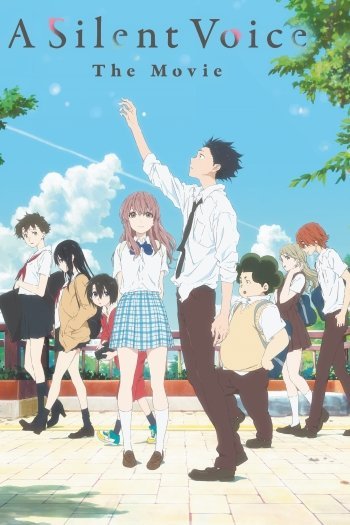
Koe no Katachi / Silent Voice (2016)
When a grade school student with impaired hearing is bullied mercilessly, she transfers to another school. Years later, one of her former tormentors sets out to make amends.
i think conceptually - this is a really nice story. redemption is a theme i feel always has a special place in storytelling, there’s something about watching the protagonist overcome the difficulties they’ve had in their past, and come back a better person because of it thats so rewarding.
I think that’s due, in part, to the way everyone thinks of themselves - humans are naturally very doubtful, and self-deprecating: the fastest to point out their own flaws. i don't think i know anyone that is genuinely happy with who they are, with everyone ashamed of some part of themselves, and their pasts.
however - the context of redemption is an important factor. there’s unforgivable acts that cause immense damage - so much so, that no matter how different they are, they can't bring themselves to forgive what they’ve done.
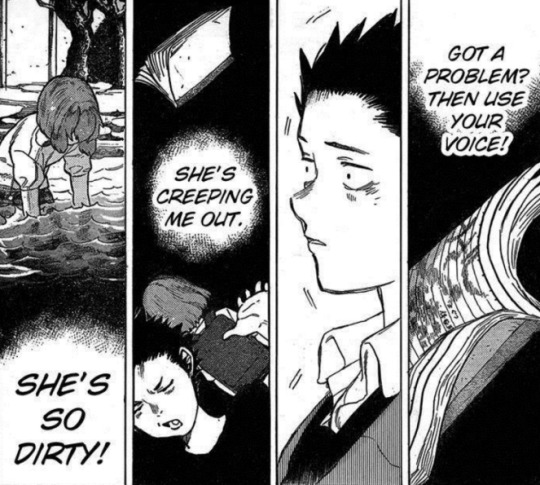
personally, i agree with the mentality that the victims of situations should be the factor that dictate whether the act is forgivable or not, but that doesn't necessarily mean you can forgive yourself.
the film centres around a boy named Shoya Ishida, who bullied a deaf girl named Shōko Nishimiya, when he was a kid - and is seeking to make amends for the way he treated her.
in the film, this is down-played, with it taking up about ten minutes of the film, as an opening segment.
I’ve both read the manga, and watched the film. The way each version is handled differently yet still tells a similar story, with the same cast of characters is a point of interest to me, and i think each version has it’s charm.
if you're interested, i personally prefer the manga version - it’s much grittier, and makes scenes from the movie a lot more understandable, due to missing content - the tone becomes understandable.
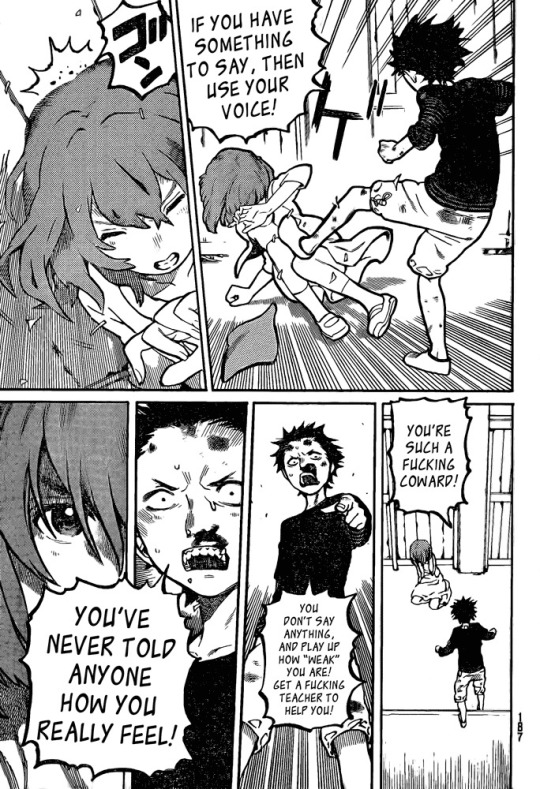
Shõko transfers to Shoya’s school, and instantly things change - with classes having to accommodate for a student, with a disability. this annoys Shoya, and his friends, and to ‘get back at her’ as they see fit they begin to tease her.
Shõko wears hearing aids, and Shoya learns that yanking them out will entertain both him and his friends. A female student, Naoko, also leads the way in ostracising the deaf girl.
Shõko does everything in her power to fit in, communicate and make friends, but due to her disability she is ultimately forced to spend her time alone. this unfair treatment seems absolutely barbaric - but the sad reality is that it happens.
i personally have a few audibly-impaired pals, and it’s upsetting to watch the way they’re treated. People find it difficult to communicate with them, and in essence - due to not enjoying the time they spend with them, isolate them. this is, of course, a generalisation based on my experience - i think that this is what makes my friendship with them feel unique - a percentage of the individuals i encounter have very few connections, which makes their bond with myself feel more significant.
Shõko is targeted by Shoya, and his gang - who pour water on, trip her up, and rips out a number of her hearing aids: one time so forcefully her ears bleed.
He is scapegoated as the only bully in the class despite how many of his classmates have contributed to Shõko’s suffering. Due to this, his friends turn their attention on him, and the torment they inflicted on Shõko is now being flipped on himself.
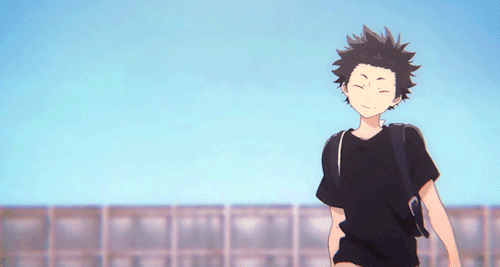
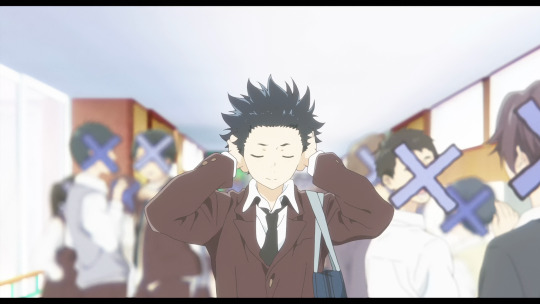
we skip over the next few years of Shoya’s life - they pass, as nothing noteworthy happens. Shoya lost everyone, now he can’t look anyone in the eyes, which is visually represented by x’s over the faces of all the students at school.
He’s alone. but accepts this as his punishment for what he did to Shoko.
i think this is one of the aspects that sold me on the film: the second you see what Shoya has become you instantly understand he’s truly changed. he’s gone from a spunky kid, swaggering down the halls with tons of friends to this sorry state.
he's resentful for the way he treated Shõko, so much so that he’s considering killing himself - conveyed by the simple and chilling way he cuts out the rest of a calendar after the date he chooses to die.
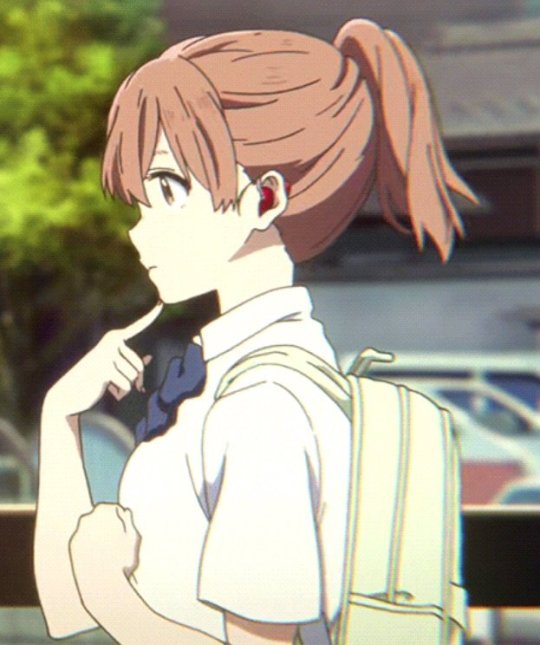
after reuniting with Shõko, the rest of the film follows the new relationship they build, along with the reactions of their old classmates.
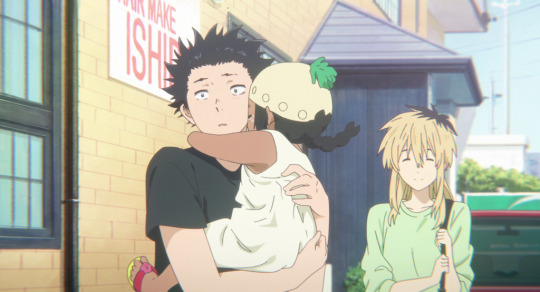
“What I have given a lot of attention to when portraying Shoya’s position and circumstances was to portray Shoya as an individual character – to carefully understand and stay true to the intentions of what he saw, what he felt and what actions he took. I have tried to build the character so that Shoya will be able to act as himself, no matter what the circumstances,” - Yamada.
It’s hard to argue that Shoya is not worthy of redemption: he works for years to pay back the cost of the hearing aids, he almost kills himself, he accepts his own isolation and misery, and he reaches out to Shoya to make amends and help her wishes come true.
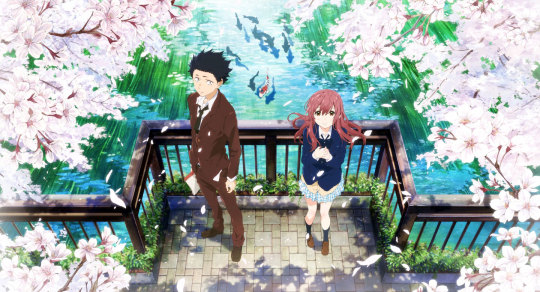
I walked away from the experience truly contemplating a lot of things. to all the people out there who picked on me at school, the ones who made me feel like shit and hate myself.
i forgive you.
and i hope one day - you can do the same. forgive yourself
5 notes
·
View notes
Text
EVERYONE’S A CRITIC
I’m one of those people who, generally speaking, can find enjoyment in everything. I don’t think there’s ever been a time after the consumption of any specific media that I've walked away from the experience with a negative stigma; not liking at-least one thing.
films with characters you can relate to
engaging storylines,

0 notes
Text
Scott Pilgrim VS. The World (2010)
from a very young age, I’ve always loved making comics. But strangely, i didn't actually enjoy reading them... i would spend hours-upon-hours a day - filling out sketchbooks and pumping out content, to show my friends when i came to school, the next week.
I remember vividly a memory of my dad taking me, and my brothers to watch Scott Pilgrim at the cinema - due to this ineptitude of not reading comics: i watched the movie, before i read any of the series.
I was about 8. so it kept my short attention span, for the run-time - and i instantly forgot about it afterwards.
coming back, years later - with a vaster knowledge, and appreciation for films: I fell in love with this film. Everything intertwines so perfectly to create such an enjoyable experience - you can really tell this movie was made by people who love the source material, as so much care was taken to create this stylised outcome.
youtube
The film follows Scott, a 23 year-old loser who meets a girl named Ramona and instantly falls in love with her - but in order to date her he has to defeat her seven evil exes.
i wanted to use this blog post to highlight some of the effects the film used, through their editing to create such a creative, visually appealing outcome.
Graphic match cut Shots that share matching visual elements such as shape, colour, size or frame composition.
for instance the scene where Scott opens the door, and is blasted by sunlight: the screen turns white, and we transition by doing a downwards pan from the sky outside.
or when Steven asks Scott to run through the song, again - when Scott questions this, the scene completely changes, yet the transition makes it believable that Steven has transitioned from the house to the street, on the way to Julie’s party in one movement.
FuN fAcTs:
in the opening title card: the long hallway where ‘Sex Bob-Om’ is written at the end was done practically.
The wall that Knives and Young Neil are sitting at physically moves backwards.
during that scene where Scott is peeing, then steps into the school hallway: they actually moved that entire room around, into an entirely different set.
That scene where Scott sees Ramona in the library and then it suddenly cuts to him in band practice: Stephen actually yells at Scott while he's still in the library. they brought him in for that literal one frame just so the movie could have a really cool transition.
stuff like this gives me such an appreciation for the film - so much effort was put into this film, to make it the best outcome it could’ve been, that it is a real shame that this movie initially flopped at the box office...
1 note
·
View note
Text
SOUND DESIGN
i think sci-fi and horror have some of the most well thought out sound design, respectively.
the sound designers, and producers work hand in hand - to combine their talents to ensure the sound and screen work hand in hand, with one another, using soundscapes in unique and interesting ways, to allow the viewing audience to be further immersed in the scene.
this ability to be able to manipulate audience’s emotions, in such a way is astonishing to me. the fact that filmmaker’s work can have the tone enhanced through the use of music is something i have immense respect for, and definitely something i try to have when commissioned with handling the audio-production of other’s work.
directors have the authority (and responsibility) to decide what audio-enhancements to use, at what particular time, that produces the best outcome. whether that be complete silence, dialogue, crowded music, etc. is all in their say.
i wanted to make this post to allow me to express some of my personal feelings towards certain media’s use of sound, and how i believe them to be effective examples of audio done right.
ALIEN (1979)
youtube
the first shot opens is extremely dark: as the barely lit outline of a gargantuan spaceship can be seen slowly emerging into the shot, from he upper right hand corner - as some information is displayed
All of the empty space in the shot allows the audience to see the spaceship is small in comparison to the size of space: making it feel in danger, almost isolated.
The information sprawled across the screen, informs the viewers the story
the ship is for cargo purposes and is holding seven crew members and is on its way back to Earth.
the font is very basic, and the colour choice is striking, amongst the dark background: making the simple statement that much more prominent.
the lack of a soundtrack as the ship passes by the camera, adds to the eeriness of the opening, as all we are forced to listen to is a strange ambience, that unsettles the viewer.
as we enter the spaceship we are reintroduced to our first non diegetic audio track; that features long instances of low strings, that sounds almost like a form of demonic chanting. with staccato, off-beat trills from high pitched strings that further put the viewer on edge.
the astronaut’s introduction gives the audience a small peak into the story. visually expressing to the audience that these seven characters on board are the only people out here, and that “IF” they should find themselves in any trouble; they’ll be forced to face it alone.
ATTACK OF THE CLONES
youtube
I think its really clever sound work. there's no sound in space because of the well known fact:
“s p a c e i s a v a c u u m”
so by having this extended silence, before the blast - the tone is really impacted.
the sudden orchestral leitmotif really intensifies the scene as Obi-Wan is suddenly the one being tracked and followed.
In later films they also use the silence method and I think its an amazing sound piece
I love the unique sounds for the ships also, they’re not what we would associate normal aircraft to sound like and that makes it more sci-fi.
Diegetic / Non-Diegetic
diegetic music is one that the characters hear such as a radio, but non diegetic is a soundtrack that emphasises the scene
0 notes
Text
VOCOCENTRISM
as the name suggests, vococentrism prioritises the dialogue, of a scene: over the other aspects (Sound Effects, Music, etc.)
for the most part, stating that the majority of films are vococentric - would be true, as directors carefully design the dialogue between characters to best convey the story, to the viewer.
however, there are a selective minority of media - that manage to break this convention: and i want to make this post to briefly address the strengths and weaknesses of a very famous example of this:
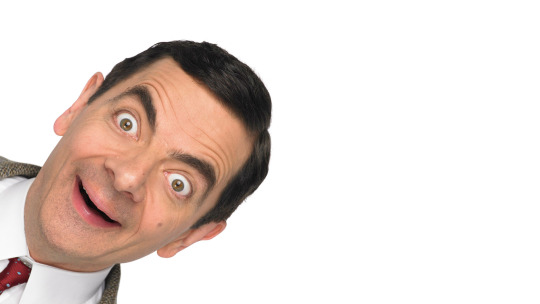
“Mr Bean” (January 1st 1990 - December 15th 1995)
despite being a British cult-classic: the original series, was short lived with only 15 (24-26 minute) episodes.
the series, starred Rowan Atkinson as a a strange, mute humanoid named: “Mr Bean” who used his unusual (albeit: entertaining) wit to fulfil everyday tasks. But more often than not, his childish antics end up creating trouble for himself and those around him...
the series thrived, with an animated spinoff: and multiple movies.
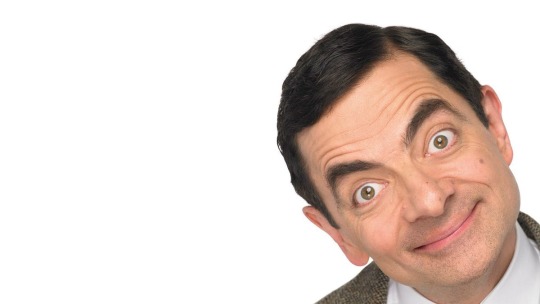
I think the strengths of the series all relate back to Atkinson’s portrayal of Bean.
Atkinson has a talent, most inherently shown through his portrayal of Bean, of being able to manipulate his face in humorous ways to convey exaggerated emotion, in the place of dialogue: much like earlier silent films, that relied on the use of music and movement to enhance the scenes.
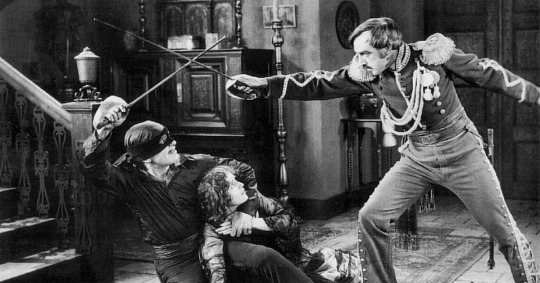
exaggerated acting is a common theme of pantomimes, and other media that appeals mostly to children: as the obvious, “in your face” way of expressing emotion is a simple way to convey this to a simple-minded audience, without them having to analyse subtle things.
Atkinson’s approach is by no means revolutionary: in fact, it’s rather simple - but that's the point. it’s appealing to children.
Mr Bean never has anything close to a normal interaction with anyone he meets - due to his limited speech, which throughout the series is used as a tool to further escalate the ridiculous situations the character finds himself in, as something that could be explained and talked through, is instead being driven further by his muttering and stammering.
in place of dialogue, Bean relies on much more physical acting; from not only himself, but the people he interacts with. this is further enhanced through the use of a laugh track, to remind the audience that the very vaudeville tone is due to the fact they’re trying to make you laugh, as this is a comedic show.
What's more, he always wears the same clothes, a common trope with characters, especially in cartoons and other children’s media: as they remain in one outfit: to keep an iconic look.
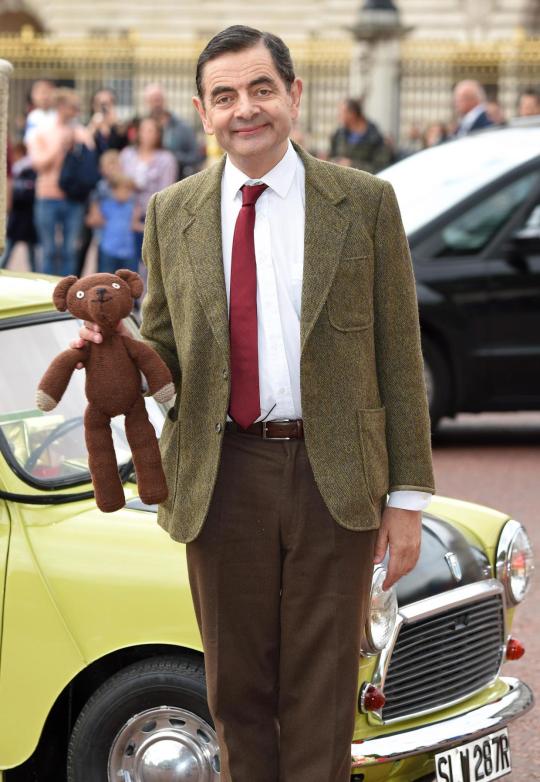
At the beginning of each episode, you see a bright light appear on the ground, it grows bigger and bigger until it stops and Mr Bean falls, which is interpreted as a comical take being beamed down from an alien spaceship.
despite being a comedic show: and Bean is strange to further this, i like to imagine that he used to be normal, which is how he has his own apartment, a girlfriend, and money. But then he was abducted by aliens, tested on, and dumped back onto Earth - with no memory of anything but his name, with it being one of the only lines he has throughout the show’s original run - in turn creating this unusual character, who doesn't know how to interact with people.
Bean’s many strengths lay within the shows reliance on not speech, but physical comedy: however, this is also the show’s downfall.
dialogue provides the opportunity for characters in world to ask appropriate questions, that the viewer may also be thinking - to expand upon the viewer’s knowledge of the world they live in.
dialogue allows characters to express more depth, articulating problems and issues, imagining life's many possibilities, seeing where things lead, evaluate alternatives - without this they have a distinct disadvantage of engaging with not only the audience, but others in their world.
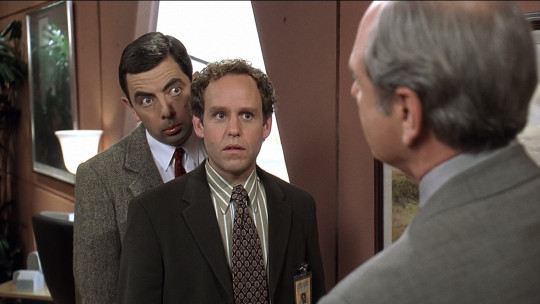
Mr Bean is a charming show. Bean as a character is interesting, while also being humorous.
in later instalments in the franchise - there is a shift in tone, with movies being a longer media than half hour episodes that featured multiple storylines, the films followed a set journey about Bean travelling to unfamiliar places (the USA, and a holiday to France.) where he has interact with people.
here, there is a much heavier reliance on dialogue to not just extend the scenes, for run-time: but also provide more depth: to justify a longer production.
with these films, the focus shifts more towards the characters bean interacts with. - the family he stays with in the USA - Bean’s interference on their lives puts stress on a constantly worrying father, but ultimately his mannerisms result in the two becoming good friends. - he helps his moody teenage daughter, open up more. - Sabine, and Stephan - an amateur actress, and a child who got separated from his father on a train: both interact with Bean, and him traveling with them aids them in their individual goals,
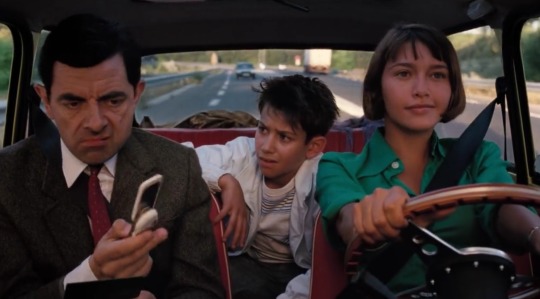
Bean remains a constant - his character already developed as far as he’s capable to. instead his use is comic relief, while the rest of the characters on stage witness his hijnix and progress the story.
this could not have been done, if the format didn't change
dialogue driven media is arguably a much more effective way at giving a viewer a more fulfilling experience.
media like Bean are an effective way of conveying short, simple storylines: fit for multiple sketches across a half-hour Tv-show. but for most other media, I’d argue that being dialogue reliant is not a weakness, but a way to allow for better storytelling.
the use of dialogue allows further acting, further world-building - there is just more sustenance to it all.
dialogue is not necessary to provide the viewer with the information they need to engage in the story, but it is a clear and concise method to deliver more, in an effective and enjoyable way.
anyway, that’s my thoughts on it at least.
1 note
·
View note
Text
Royal Tenenbaums, Wes Anderson
Anderson’s films are very distinctive, they could be described as “hyperreal” - the film doesn’t quite go into fantasy worlds, but it is an exaggerated version of reality - very similar to that of “Lemony Snicket’s: A Series Of Unfortunate Events” he doesn’t find a place to film, and film it - he controls the sets, setting and clothing - i think this is why he went into stop motion, later: where everything is designed specifically.
we open with ascending, and descending scales on a stringed instrument: what i believe to be a harp - as the production company is displayed. the colour scheme is bold - blue on black, it looks sleek and professional - already settling the viewer into the themes the movie is pushing.
from there, we get a very simple overhead shot: where a transaction - taking a book from a library, is shown. the title of the film, sprawled across the book - in a pink font.
this opening is genius, it gets the title across in a creative manner - whilst subtly hinting what the film is about through the use of the book.
i especially liked the use of the physical book to show the title of the film. it is designed well, to make it believable that this is a real book: at first i thought it was a visualisation of a novel, but it was not.
i think the use of the book was a deliberate attempt to tell the audience, straight away that this film was a STORY, rather than a word for word retelling of true events. Perhaps, in an attempt to separate itself from seeming real, Tenenbaums wanted the freedom to exaggerate aspects of reality to create the unrealistic circumstances and themes he can play around with in his story.
we transition, to seeing this book cover multiple times: perhaps on the shelves of a store.
- the first shot shows many books, - following this is fewer books: closer up - finally we see the book cover set-up: consisting of real world counterparts of the objects seen on the book.
this is an attempt to put us, the viewers: quite literally into the story - Wes Anderson has shown us, through the conversion of the cover: into reality that we are now amongst the pages.
from here, we are introduced to the prologue: with only a few lines of text, illegible - as they are cut off, we are not to read the story ourselves: we are told it, by the voice-over narrator, who is supposedly reading from this book. perhaps the narrator is a self insert, with him telling us the story, the way he wants to - without us interpreting things our own way, as he is a figure that is quite literally telling us it.
the narrator’s voice is calm, and noticeably deep: stating the story through facts, with the scenes explaining themselves, so the audience doesn't have to interpret anything without it being directly told to them.
its here the soundtrack kicks in, with a harpsichord version of “the Beatles: ‘hey Jude’” - i think this is Anderson’s attempt at creating a setting that is quite familiar, to the audience - setting the time period of the film - with recognisable elements, to the audience, to aid them in understanding the telling of this story.
from the initial shot of the street I assume this film is set sometime in the 1970s: as that’s a popular time period for the Beatles. from the accent of the narrator and the depictions of the city - I’d say this is definitely American-based, perhaps New-York, to be more specific?
there are three windows: each of varying levels - the top window features, first, a girl - reading by her window - the second, a boy reading a newspaper - the lowest, a boy frantically sketching.
we see a man, to the right of the shot, knock on the door - the fact that his arrival isn't centralised suggest that this event is to be looked over, and is unimportant.
we suddenly cut to three well dressed children, each posing in ways that help the audience understand their characters.
* to the left, a shy looking girl: head down, hands tucked under the table * the centre, a confident looking boy - well dressed, with a stern expression and folded arms * and to the right, a long haired squinting boy, pulling an odd expression - his arms resting on the table
from this shot alone, we can tell so much about the characters - and it is implied that the central most one, will be the main character: with symmetrical candlesticks and windows helping reinforce the fact that the shot has been framed with him as the focal point.
the use of central composition - makes everything look staged, which adds to the hyperrealistic tone.
the father “Royal” is sitting on the other side of the table, twiddling his hands nervously while making excuses to his children - we can tell he is quite distant from them. The use of a low angle shot - puts the father above his children, suggesting he was difficult to reach out to.
the father is very dismissive of the children’s questions: giving quick responses to portray him as a good person, hiding the truth about why the two are divorcing.
he seems to be the type of guy who says the wrong thing - without considering how it will make them feel: by stating that having children causes certain sacrifices when asked “if it’s (their) fault for them getting divorced”
this is very indifferent to the mother, who is much more involved in the scenes - and puts the interests of her children first
The mother was off centre - showcasing that even though she’s their mother, she’s no better or more important than them, with her being swaddled in with them, sitting down: while they were standing - almost as though the children where higher than her and had control of her, especially when asking for the cheque, or hanging up the paintings for Richie.
Anderson (the creator) was literarily educated - with a vast range of influences from literature to aid on his films. I like to think that the fact Anderson is well educated; is what influenced the children being portrayed as adults, described as prodigies.
Chas is a businessman, “taking his meals in his room standing behind a desk with a cup of coffee to save time” The children are associated and filmed doing adult activities much beyond their actual age, that helps make it seem unreal
The children are always showed in a neat, sometimes empty composition. their clothing is exaggerated - and doesn’t change, almost like cartoon characters: with their wardrobe design linking to the type of character they are.
there is a predominant use of reds - it’s a colourful film, but the harshness of the colours are toned down.
1 note
·
View note
Text
Coraline, Henry Selick (2009)
the clip starts with an unsettling establishing long-shot of the “pink palace apartments”.
the colour scheme is very saturated: with the most prominent part of the frame being the central, house.
The palace - is in actuality a dilapidated mansion, renovated apartment complex; once a house for one family, divided into several apartments.
Something as vibrant sounding as the ‘pink palace’ is in actuality very dull, and victorian looking. Perhaps referencing the theme of empty promises, with the main character constantly stating their desire to “go back home”
a tall, strangely proportioned figure is seen squatting on the roof.
(strange greyish blue skin: long slim arms, and legs - burly, macho chest and a long moustache)
strange accent, speaking a different language - this film’s perception of a foreign man, is contorted - with odd behaviours, and appearances
As the car approaches, he cups his brow - actioning that he is watching them
new arrivals are of interest, nothing changes here in this apartment complex: everyone living there is contempt with the lifestyle they have; so Coraline’s arrival will disrupt this equilibrium.
he staggers, almost falling - shaking his fist at the approaching car, before crossing his arms, confidently - and jumping down to an unknown section, behind the house
the figure shaking his fist is perhaps a signal of things to come: that things are not what they seem, and this incredibly dull, boring looking setting is hiding darker tones
the camera pans lower, its eerily silent as the sounds of the approaching car and moving truck pull towards the central piece.
a descending scale of plucks on a harp play, as the figure on the roof disappears to an unseen place - behind the house, which worries the audience, as jumping from the top of the roof is usually seen as lethal.
the film is primarily stop motion: sense of controlled elements - with everything especially designed for the scene.
two, fairly normal looking, moving men open the latch to their van - filled with boxes, subliminally telling the audience the story: without having to directly tell them, whats happening. In this case, that a new family is moving into the pink palace
they begin bringing furniture to the door, as a grotesque woman uses a stairlift to come to the top of the stairs: observing their actions, again reinforcing the idea that this community finds new arrivals an interesting, and unfamiliar event.
she waves, flirtatiously and giggles at one of the moving men, who takes no notice of her - their role in the story, is no more than to move the main characters into their setting.
the music begins to build up here, with more elements of the story falling into place - more instruments and parts of the soundtrack coming in.
the strings play a repetitive baseline, and a seemingly erratic / random melody is played on some kind of keyboard instrument, perhaps a harpsichord
with the job done, the men take their leave.
this shot is framed so you cannot see the central character, signing off on the deliveries completion: keeping the audience in suspense of who this individual is, and the power they clearly hold over the (assumed) family, through them being not only the first of these characters we see, but the primary figure - signing off on important documents.
the fact this figure is hidden behind the door, could also be a hint that they are closed off, too focused on their tasks to make time for the members of their family.
she closes the door, swiftly: implying the duo to leave, but not before the man stops the door with his foot, and subtly holds his hand out, to ask for a tip: only to receive a single crumpled up dollar note.
looking at the house their moving into, the fact the drive a car, and the items of furniture that were carried: i ruled out the conclusion of them being too poor to afford tipping: perhaps the family is quite stingy with their money, focusing their spending on things that are necessary, as the figure behind the door neither thanks the men for their work, and had no intention of tipping them.
it was only upon being forced to, that she spared a singular dollar: much to the man’s disappointment.
this sets up the idea that this mystery figure is the head of the family, and someone who is too invested with their work for other people, most likely: the family that surrounds her.
the moving van leaves, as a black cat enters the frame: an expressionist symbol for bad luck.
it’s tail is crooked, with jagged unnatural corners that build up its shape.
the audience is conditioned to believe the cat is bringing with it bad luck, and that now that the movers have left: so has the safety of equilibrium…
a door creaks, alerting the cat: as the camera turns to girl in a yellow raincoat.
the colours in this shot are very muted and grey - in contrast to the girl, with her blue hair and her bright yellow coat - she stands out amongst the greyness.
this signifies her as the primary focus of the film: the titular character, “Coraline”
the dull colour scheme, seems to me: as a representation of her perspective of the world, the colours show how she finds her normal life boring
it could also be a reflection of her emotions - perhaps, as shown through her mysterious authoritative figure; Her family life isn’t very happy, and moving has caused her to be in a bad mood - hence why she is going out for a walk, as most people do: to clear their heads, when in a particular state of mind.
Theres a noticeable music change when we first see Coraline enter the scene, from her perspective she is looking at the garden: what is congenitally a place blooming with beautiful natural forms, and life, is instead very uninteresting, and eery.
harmonic vocal music, accompanied by harp - enforcing quite a heavenly trope, about Coraline: reinforcing the idea of her being the protagonist in this story. the lyrics are unintelligible, as far as I’m aware: adding to the child-like aura surrounding our central character.
in one swift, decisive motion: Coraline snaps a twig from a discoloured bush, and strips it of its leaves, closing her eyes - and beginning a strange, emotive walk cycle - almost as if being lead by it.
in reality, this is a play on the myth of a “diving rod” a Y-shaped twig, or two L-shaped ones - that will supposedly help find underground water. The rods are typically held in a position of unstable equilibrium, so that a small movement gets amplified into a big movement. Typically, the person that is dowsing holds sticks, and walks around a property in the hopes that the rods will dip, twitch, or cross when they walk over the underground water. The dowsing rods do indeed move, but not in response to anything underground… They are simply responding to the random movements of the person holding the rods.
I like to think Coraline’s use of a dowsing rod exclaims that she is open to the idea of the supernatural, and settles us into the magical journey we’re to embark on - through her belief in finding water with just a stick.
the cat follows Coraline around, further showcasing that equilibrium is to be broken, and this girl is going to go on some form of journey that will disrupt the current flow of things.
the first line of dialogue is spoken, on her walk: she only talks when she leaves her house - perhaps showcasing a difficult home life, where she can’t be herself around the people closest to her, as maybe they don’t understand her.
the music evolves, with the strings from before now playing in a minor key, as Coraline fearfully runs deeper into the woods. as she gets deeper, large timpani drums imitating a fearful heartbeat the vocals from earlier, are played with - with the convention of what was angelic before, now sounding much more demonic: with three distinct pitches, perhaps signifying three as a significant number in the film… further in dissonant held brass chords play
the deeper she gets the more instruments join into the soundtrack: with this thicker texture, the situation seems more tense. this is supported through the overall composition’s change from bright and colourful, to scary and frighting the deeper into the woods Coraline wanders.
perhaps her destination (towards the well) is an area of darkness, with all this surrounding scenery to compliment this idea.
Coraline stops dead in her tracks, inside a circle of rocks; perhaps an occult symbol - with her essentially being summoned into this world by the producers of the film
Coraline mocks the cat for not talking, perhaps setting up a convention to be broken later in the film
she also refers to her rod as “magic” - again signifying the fantastical nature that the film is portraying.
a masked rider, on a bicycle (a play on the horseman of the apocalypse) with a skull mask (symbol of death) rides towards her, from atop the hill. despite the very threatening mask, it turns out to be a boy named Whibey - seen more as annoying than threatening introducing the idea that things are not what they seem: and you should “never judge a book by its cover”
0 notes
Text
a Clockwork Orange, Kubrick (1971)
Hi:
I’m Ike. I’m an 18 year old British student who spent most of his life in the UAE.
right now, I’m in the second semester of my university degree, and this will be a blog where i am documenting my thoughts, findings and work alongside my studies.
for my first lecture, we looked at the opening to...
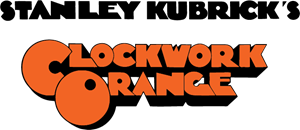
i wrote some notes, and didn’t want them to go wasted - so i figured I’d invest some time into writing a detailed analysis of the opening, and posting it onto the TUMBLR blog you're reading right now!
this is how we’ve been showcasing our work the majority of our modules this year. At first i wasn't proficient with using the site, but after the first semester: i think I’ve started to get the hang of it.
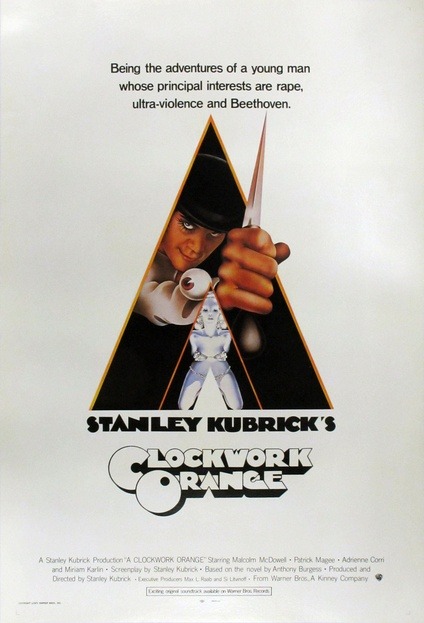
the film starts, with loud staccato inceptions over a piercing red screen. bold text introduces the production companies, with each new company flickering between red and blue, two very polarising colours. perhaps settling the viewer into the world of this film? as the instant juxtaposition with two very distinct, alternating, bright colours, against piercing string inceptions conveys a sense of unorthodox.
the title itself is a point of interest: to say that one has the appearance of a natural organism: with a distinct, bright orange colour, and delicious juice - but is in fact only a clockwork, mechanical entity - this, again creates a sense of things not being as they seem, through juxtaposition.
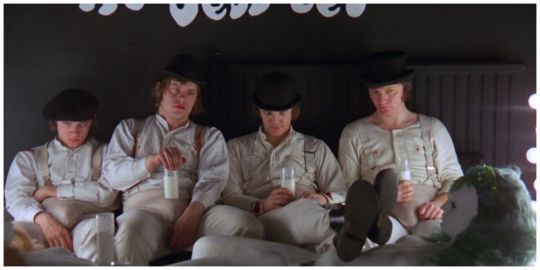
we instantly cut, on beat a man with an inked on eyelash appears in the centre of the screen, looking directly at the viewer, with his head tilted downward - and eyes peering upward from beneath his eyebrows (the Kubrick stare). as the camera zooms out we see three of his cronies sitting on either sides of him: enjoying glasses of... milk?
the way the central character slowly swigs from his glass, is menacing; and adds to the uneasy tone, the scene is creating.
one of the first things that stood out to me was their dress sense and how it contrasts with the dark background.
they are very dandy - unduly concerned with looking stylish and fashionable, with their bowler hats and makeup. speaking of which - they each have their makeup for each part of the face:
- the leader (Alex) has the lashes, - first to his left (Dim) has lipstick, - far left (Pete) has eye shadow on his left eye, - and to the right (Georgie), coloured eye shadow on his brow.
white is a colour that suggests purity - further emphasised by the child-like milk drinking, this is potentially a way of showcasing these are the protagonists of this film - the “good guys” however throughout later scenes, of intro they are seen as thugs, on multiple accounts: first attacking an innocent bystander, but later brawling with a rival gang, and saving a woman from their clutches.
i especially like the way conventions are played with, and even broken - it’s almost as though Kubrick is saying there’s no innocence, or safety in the world.
the camera pans out further to show more people, much bulkier - potentially guards of some sort, due to their placement: protecting the central four.
as we get further we see a walkway, leading towards the four - surrounded by multiple female mannequins - in grotesque, sexual positions - implying the woman of this society are very low level: showcased as furniture.
Kubrick did a good job instantly making the viewer feel uneasy...
a faceless voice, suggested to be the central character calmly, narrates over the scene. the walls are littered with phrases; each containing the word “moloko” which is based off the Russian word (молоко) for ‘milk’
he introduces himself, and his cronies - as well as the different types of milk served in the milk bar
- Moloko Vellocet (mixed with opiates), - Moloko Synthemesc (mixed with synthetic mescaline) - Moloko Drencrom (mixed with adrenochrome and other hallucinogens).
stating they’re drinking “Moloko Drencrom” - as it will
“sharpen (you) up for a bit of the ol’ ultraviolet”
the entirety of the scene is very strange - arguably quite off-putting.
the scene suddenly cuts to a homeless man, laying on the ground: loudly belting out a drunken old nursery rhyme (“Molly Malone” by the Dubliners)
In Dublin's fair city Where the girls are so pretty I first set my eyes on sweet Molly Malone As she wheeled her wheel-barrow Through streets broad and narrow Crying, "Cockles and mussels, alive, alive, oh!"
the shadows of the four delinquents, seen earlier begin to approach him. There is a use of a lot of extreme lighting, very large - and harsh shadows which add to the sinister tone this scene is building.
the silhouettes of the four boys, continue to approach - confidently striving, forward - with a bright streetlamp illuminating them, from behind: just enough to be recognisable, but not enough to identifiable. the most central one: is armed with a melee weapon of some kind, menacingly resting upon his shoulders. I find this dynamic to be very stylised - suggesting that they do this as an art, rather than just mindless violence.
as the gang approach, the narration continues; stating...
“one thing i could never stand was to see a filthy dirty old drunkie howling away at the filthy songs of his fathers and going blurp blurp in-between. as it might be a filthy old orchestra in his stinking rotten guts. I could never stand to see anyone like that, whatever his age might be. but especially when he was real old like this one was”
the use of such hateful, condescending language suggest that this man, is under the belief he is of a higher class, and thinks he’s better than the homeless - seeing them as a problem, that must be eliminated, rather than as equal human-beings.
not only that - he creates an instant distinction between those who are “old” and themselves, this suggest they are young, and that gang violence is a growing problem with youngsters.
the gang condescendingly claps down to the drunk, and cheers at his singing, but as the viewer - we know that this is disgenuine, and begin to imagine what the delinquents are about to do to the man: now that they have engaged in a situation, after drinking the “Moloko Drencrom”.
the man asks for change in an informal, and friendly way: with his hand raised up, begging for help - the crew literally looking down on him.
despite his friendly demeanour, and desperation - he is responded to by being laughed at by the cronies, as the leader plunges his gentlemen’s cane, harshly into his stomach.
the way the group are represented as such charismatic villains: people who do awful things, with such an attitude that you are interested in the viewing of them is a genius standpoint of telling a story, as once again it breaks convention - with the protagonists we’re following the story of being villains, rather than a typical hero.
the irish drunk asks the men to kill him - as he’s
“sick of living in a stinkin’ world like this”
the serious tone of this scene is emphasised by the lack of music - but contradicted, by the most prominent audio: the cronies laughing in the background - this makes it seem like the characters aren’t taking this encounter seriously, and are having fun and doing what they want.
the camera has a habit of showing the faces, of the characters from very close-up, which adds to the abnormal nature and overall uncomfortableness the viewer feels watching this film: by making them feel quite claustrophobic. despite only able to watch each event occur, the viewer is involved in the scene due to their direct viewing and uncomfortable closeness to the characters; through close-up shots.
I also noticed that the boss is the only one who initiates conversation, which showcases the respect the cronies must have for him - to allow him to dictate how the encounter goes.
the boss, smugly asks why its a “stinkin’ world” to which the drunk responds...
“it's a stinking world because there's no law and order anymore! It's a stinking world because it lets the young get on to the old, like you done. Oh, it's no world for an old man any longer. What sort of a world is it at all? Men on the moon, and men spinning around the earth, and there's not no attention paid to earthly law and order no more.”
Kubrick, through this character has done some very early world building: and directly told the viewer that this is a world where the young, are in gangs and are free to attack the old.
men on the moon is talking about the abnormality of the situation - as it is not the way the world should be. in his opinion; the “earthly law” has been broken - as there is no consequence for breaking it, and as such everything is out of order.
he goes back to singing a different song, when the gang beats him with concealed blunt objects, curb-stomping him.
it is clear they’re trying to portray this gang as juvenile criminals, as although they are causing problems and breaking the law: attacking what by all means are innocent people; they are using blunt objects to beat them - which is quite tame especially compared to the next scene, which gives a good intro to the film is about...
a very upbeat, iconic classical medley begins, as the distant screams of a woman can be heard. despite the distressing sound: the scene attempts to establish a sense of calm through the initial shot being the floral pattern on the walls of an abandoned theatre. the camera begins to zoom out, showing more of the scene: where a gang of five lads, are forcibly stripping a woman and throwing her on a mattress, with intentions to rape her.
the narration reveals this is the work of “Billy-Bob” - and comedically states they’re going to “perform a bit of the ol’ in out in out”
this scene uses comedy, and music to make the whole thing feel rather lighthearted and juvenile, in contrast of the severity of what’s actually going on. This extreme dissonance adds another layer of uncomfortableness for the viewer: being forced to watch this woman be overpowered by this gang.
the scenes length, further adds to the uncomfortable nature - as the viewer s=is unable to do anything, helplessly just watching as the unspeakable act occurs.
this gang visually look like a lot more serious offenders - with a dark green, military-like ensemble of outfits, and much more aggressive, serious crimes.
their weapons differ too, with Billy-Bob’s gang using blades, a much more serious, lethal form of weaponry - compared to the blunt clubs, bats, and canes of the four goons: who are more camp.
the fact this scene takes place in an abandoned theatre suggests that this is what’s replaced the theatre. what was once a haven for artistic expression is now a dangerous gang infested zone.
the leader of the goons very elaborately enters the scene, from the dark - with his cronies at his side. making sly remarks at Billy’s gang
the very theatrical nature of the goons, instead of just "violence and murder" as seen with Billy’s group - is what i think, makes Billy’s gang lose interest in the girl - as their confidence is extremely sinister, in my opinion.
it’s as Alex insults Billy that we get a closer look at the gang’s attire: where the Nazi imagery is very apparent. further adding to the severity of how dangerous his gang, and actions are. As nazi’s were fascist extremists.
he confidently draws a switchblade with a menacing smile, spitting out his chewing gum. before calling his boys to attack
the fight scene is portrayed very comedically, with the gangs having a good ol’ brawl - accompanied to classical music - which juxtaposes the scenes: where it is upbeat while the scenes are showcasing these exaggerated acts of violence.
despite being five of them: the knuckleheads energetically scrap with the rivals.
the elaborateness of this scene is astonishing: with them sometimes appearing inept in combat...
flailing their arms in circles, dog-piling, tackling to the ground
and other times appearing extremely competent...
humorously smashing chairs over enemies, breaking bottles and throwing Billy’s gang through windows
the scene ends with them victoriously beating them when they’re down on the floor - instilling hope, that although juvenile criminals - this gang is more competent than a larger gang of some of the most evil people conceivable (extremist, rapist, criminals)
the leader notices sirens from outside, and whistles to his crew: one comedically still in a bloodlust - causing him to continue whistling, to signal them of danger. the danger being police
the fact, that in this crime-ridden world: police still exist, and install fear in this competent gang of miscreants further suggests that they are more than just delinquents, and know the extent of their crimes.
as they run away humorously screaming - the scene suddenly cuts, to them escaping in their car. celebrating like a couple of children.
they go under a truck and cause a passing car to crash - showing they’re driving on the wrong side of the road. all the while, chuckling loudly. maybe they only do what they do for fun, and won't go to extreme lengths like other gangs: which is why their story is being followed. its why they can make light out of horrific situations.
its why they commit crimes: because its a laugh to them.
despite being seen as a problem by society: I’d argue the group see themselves as heroes; cleaning up the city - stopping rapes, “solving” homelessness, etc.
and having fun while they do it
1 note
·
View note